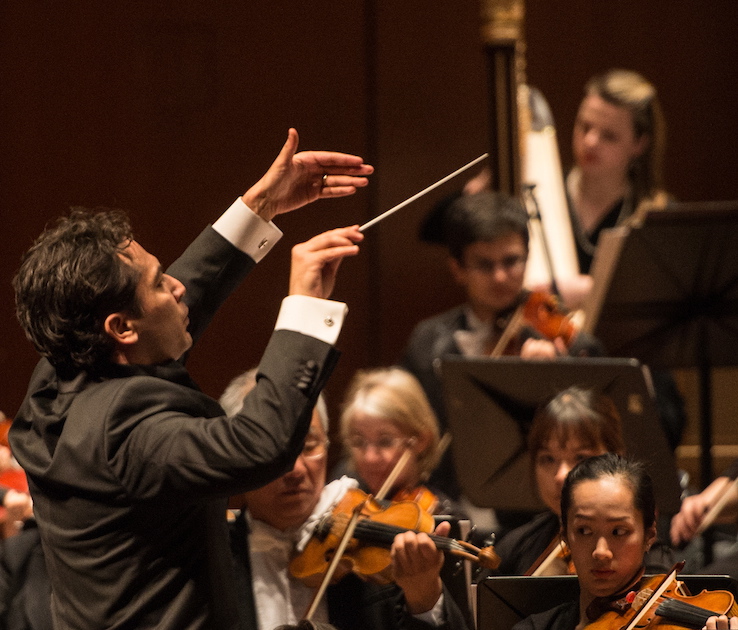Houston Symphony finds a congenial home for belated opening concert

Andres Orozco-Estrada conducted the Houston Symphony Thursday night at Rice University’s Stude Hall. File photo: Wilson Parish
After Hurricane Harvey’s flooding forced the Houston Symphony to cancel the first two weeks of its season, the orchestra finally opened its 2017-18 classical series Thursday night. But that didn’t mean everything was back to normal.
The underground parking garage that serves Jones Hall for the Performing Arts, the orchestra’s home, is still out of commission. So the group has taken refuge at Stude Concert Hall in Rice University’s Shepherd School of Music, and will return there for the next two classical programs (which have been substantially revised)
As a gesture to the orchestra’s storm-battered hometown, the group turned this weekend’s performances of Antonin Dvorak’s Te Deum and Gustav Mahler’s Symphony No. 4 into free concerts for the Houston community. In a speech from the stage Thursday night, principal cellist Brinton Averil Smith pointed up the musicians’ solidarity with their fellow Houstonians. Harvey destroyed or badly damaged 12 players’ homes, he said. But some of those same musicians have volunteered alongside other members of the orchestra to perform at shelters for residents whose homes were ruined.
Music director Andres Orozco-Estrada added that the city’s ability to resume life after the upheaval had won his admiration. When he gave the downbeat for the Te Deum, the storm turned out to have at least one silver lining: The orchestra and Houston Symphony Chorus came across with more fullness, warmth and immediacy in the 1,000-seat Stude Hall than they ever have in their usual home.
Not only are the acoustics dry at Jones Hall–a sprawling, 2,900-seat multipurpose theater built in 1966–but choral music presents a special dilemma. Whereas the voices project better, on the scale of things, to the main-floor seats, the orchestra’s sound goes more to the first balcony.
But in Stude Hall, the orchestra and chorus were both resonant and vivid, enhancing the Te Deum’s fervor. In the opening, the chorus’ jubilant declarations rang out clearly and sonorously; the orchestra bustled along jubilantly without competing.
When soprano soloiist Mojca Erdmann launched into the lyrical “Sanctus,” that was in a way the most compelling moment. Not only did her fresh, vibrant tone project easily, but the woodwind solos that punctuated her melody also bloomed: They redoubled the music’s euphony and charm rather than just sitting in the background.
The brasses’ gleaming fanfares set a new tone for “Tu, Rex gloriae,” and bass Nicholas Brownlee’s booming tones were just as arresting. Though he didn’t sound as steady in the opening phrases’ quieter, lower parts, he went on to bring the music urgency and impact. The chorus’ interjections added powerful contrast: first the women’s sweetness, then the men’s mellowness.
In “Salvum fac,” an urgent plea for mercy, the orchestra and chorus gave the music a vigor and ruggedness that harked back to the scherzo of Dvorak’s Ninth Symphony, which Dvorak composed not long after the Te Deum. And thanks to Stude’s acoustics, another plea for mercy–the men’s “Miserere nobis”—was as powerful as it was hushed. The men’s intoned prayer, the trombones’ and winds’ deep-voiced chords, and the plucked double-bass line all exuded gravitas.
If Orozco-Estrada essentially let the Te Deum flow–nuanced and evocative though he made it–he and the orchestra savored the emotional hairpin turns in Mahler’s Symphony No. 4.
In the deceleration that colors the very first phrase, Orozco-Estrada didn’t quite hold the orchestra together. But for the rest of the symphony, he had the orchestra in hand, and the group played with zest, lyricism, grace and fire. The bite of Mahler’s ironic outbursts set off the coziness and relaxation of his country-dance passages. The smoothness of the lyricism was all the more compelling alongside the force and sweep of the symphony’s surges of passion.
Time and again, Stude’s acoustics magnified the power and allure of the orchestra’s playing in ways Jones never does. In the first movement, the cellos sang out their melodies effortlessly, and their dances with the double basses practically floated on air. In the second, the winds’ solos, especially those of the French horn and clarinet, boasted a hale-and-hearty swagger.
The violin solos, played by guest concertmaster Ying Fu–the Philadelphia Orchestra’s associate concertmaster–had a ghostly, sardonic edge. In the slow movement, the strings’ warmth and purity created a serenity that wiped away the world’s tumult, paving the way for the finale’s vision of heaven. And Erdmann’s bright, clear singing brought out that vision’s simplicity and spirit alike.



Posted Sep 16, 2017 at 7:56 am by George John
Excellent review! I hope to live to see the day our orchestra gets the hall they so richly deserve. Jones is a (too) large multi-purpose venue. A dedicated orchestral hall is what is required. Your review drives that point home as well as any I have seen. Thank you.
Posted Sep 23, 2017 at 9:10 pm by John Epstein
Wonderful to find and read this informed and perceptive review. Houston lacks not only a worthy symphony hall, but also a classical music radio station, and a major newspaper with a highly-trained and experienced classical music critic. Thanks for taking up some of the slack, and here’s hoping your coverage continues and expands.